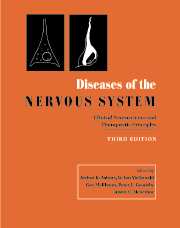Book contents
- Frontmatter
- Dedication
- Contents
- List of contributors
- Editor's preface
- PART I INTRODUCTION AND GENERAL PRINCIPLES
- PART II DISORDERS OF HIGHER FUNCTION
- PART III DISORDERS OF MOTOR CONTROL
- PART IV DISORDERS OF THE SPECIAL SENSES
- PART V DISORDERS OF SPINE AND SPINAL CORD
- PART VI DISORDERS OF BODY FUNCTION
- PART VII HEADACHE AND PAIN
- PART VIII NEUROMUSCULAR DISORDERS
- PART IX EPILEPSY
- PART X CEREBROVASCULAR DISORDERS
- PART XI NEOPLASTIC DISORDERS
- PART XII AUTOIMMUNE DISORDERS
- PART XIII DISORDERS OF MYELIN
- PART XIV INFECTIONS
- PART XV TRAUMA AND TOXIC DISORDERS
- PART XVI DEGENERATIVE DISORDERS
- 115 Genetically engineered models of neurodegenerative diseases
- 116 Motor neuron disease
- 117 The hereditary ataxias
- 118 Huntington's disease
- 119 Progressive cerebral degeneration of childhood
- 120 Mitochondrial encephalomyopathies
- PART XVII NEUROLOGICAL MANIFESTATIONS OF SYSTEMIC CONDITIONS
- Complete two-volume index
- Plate Section
117 - The hereditary ataxias
from PART XVI - DEGENERATIVE DISORDERS
Published online by Cambridge University Press: 05 August 2016
- Frontmatter
- Dedication
- Contents
- List of contributors
- Editor's preface
- PART I INTRODUCTION AND GENERAL PRINCIPLES
- PART II DISORDERS OF HIGHER FUNCTION
- PART III DISORDERS OF MOTOR CONTROL
- PART IV DISORDERS OF THE SPECIAL SENSES
- PART V DISORDERS OF SPINE AND SPINAL CORD
- PART VI DISORDERS OF BODY FUNCTION
- PART VII HEADACHE AND PAIN
- PART VIII NEUROMUSCULAR DISORDERS
- PART IX EPILEPSY
- PART X CEREBROVASCULAR DISORDERS
- PART XI NEOPLASTIC DISORDERS
- PART XII AUTOIMMUNE DISORDERS
- PART XIII DISORDERS OF MYELIN
- PART XIV INFECTIONS
- PART XV TRAUMA AND TOXIC DISORDERS
- PART XVI DEGENERATIVE DISORDERS
- 115 Genetically engineered models of neurodegenerative diseases
- 116 Motor neuron disease
- 117 The hereditary ataxias
- 118 Huntington's disease
- 119 Progressive cerebral degeneration of childhood
- 120 Mitochondrial encephalomyopathies
- PART XVII NEUROLOGICAL MANIFESTATIONS OF SYSTEMIC CONDITIONS
- Complete two-volume index
- Plate Section
Summary
The hereditary ataxias are a group of disorders characterized by motor incoordination resulting from dysfunction of the cerebellum and its connections. Although these diseases are easily recognizable due to the obvious cerebellar dysfunction, distinguishing among them is no easy matter. On the one hand, there is a great deal of clinical overlap between genetically heterogeneous diseases; on the other, the manifestations of any given genetic ataxia are protean. Today, although we as clinicians might wish to believe otherwise, we feel forced to conclude that in most instances, once a general diagnosis of hereditary ataxia has been made, determining the specific type relies more on genetic testing than on clinical criteria. Genetic testing, because of its specificity, is a powerful tool; if positive, the diagnosis is irrefutable. This might suggest that the role of the neurologist has been circumscribed, but this is really not the case. Rather, we must take on new responsibilities. Not only must we become familiar with the scientific, ethical, and statistical implications of genetic testing, but we must also learn how best to counsel our patients, an activity previously limited to geneticists in tertiary health-care centres.
The hereditary ataxias fall into two main classes. The first group of ataxias result from enzyme defects and can be either intermittent (e.g. when caused by defects in intermediary metabolism) or chronic (e.g. ataxia telangiectasia, caused by deficiency in DNA repair). These ataxias are inherited in an autosomal recessive or X-linked manner and are typically present in childhood. The second group, consisting of the progressive degenerative ataxias, do not appear to be caused by catalytic abnormalities. They can be further divided based on the mode of inheritance: the autosomal recessive ataxias, of which Friedreich's ataxia is by far the most common; the relatively large group of autosomal dominant inherited ataxias; the rare X-linked ataxias; and, finally, those resulting from defects in mitochondrial function. In this chapter we discuss the genetics of hereditary ataxias within this broad framework, focusing on the chronic degenerative ataxias and their differential diagnosis.
Ataxias resulting from specific enzyme defects: the metabolic ataxias
This heterogenous group of ataxias are best viewed as a subset of inborn errors of metabolism. The cerebellar dysfunction stems from specific enzyme defects that result in either toxic by-products or a deficiency in metabolites that affect neuronal function.
- Type
- Chapter
- Information
- Diseases of the Nervous SystemClinical Neuroscience and Therapeutic Principles, pp. 1880 - 1895Publisher: Cambridge University PressPrint publication year: 2002
- 2
- Cited by

